Riding With Vikings
Originally posted on March 27, 2019 at 4:20 amOriginally this story appeared as our cover story for Issue #202. We are always grateful and excited when Leslie’s work shows up in our inbox. A world traveler, mountain biker, and a fantastic photographer, we are very excited to share this feature with you.
By Leslie Kehmeier
It’s 10:30 p.m. on Day 5. It’s just getting dark and our group is (kind of) lost on Reinesfjellet, the biggest sea of granite I have ever ridden through. In front of us, the sun is finally about to set behind the mountains far in the distance, silhouetted by a color explosion of purple, orange and blue. Behind us, the moon is rising above sheer granite cliffs, the highest in this part of Norway. We’re not supposed to be out here this late, but for a number of reasons, we are. Weaving through large pools of still water, we soldier on, the shapes of the mountains and the patterns of the sky reflected below us. In my experience, these particular moments, being off schedule and off course, usually lead to one of two outcomes: We are either going to suffer and fall apart or we will embrace the present and have an amazing experience. Since we were facing 1,000 feet more of climbing and pushing before a steep, slabby and most likely slippery descent, it could go either way. Thankfully, after the experience of the last four days of lack of light, gnawing hunger, and jet-lagged fatigue, my gut knows we will transcend to finish an unforgettable ride in one of the most stunning landscapes any of us has ever seen.
A few days earlier, I’d stepped off my Scandinavian Airlines flight from Oslo with bike bag and duffle in tow to start a new adventure. I had few expectations for what the mountain biking in northern Norway might be like. I would be visiting for 10 days, riding trails from south of Narvik, deep into the Lofoten Islands. This part of the world had not been anywhere on my radar until a friend asked me to join one of his exploratory guided tours earlier in the year. After committing to the trip, I booked a ticket for Harstad/Narvik Airport and then did my usual travel research. I found plenty of amazing photos for the region, showing a setting that looked like something very close to an outdoor paradise. With my interest piqued for how that might translate to the riding, I dug deeper to find a surprisingly small amount of information regarding mountain biking. I saw this as a blessing, not a curse, and was happy that I added a few extra days to explore the trails on my own.
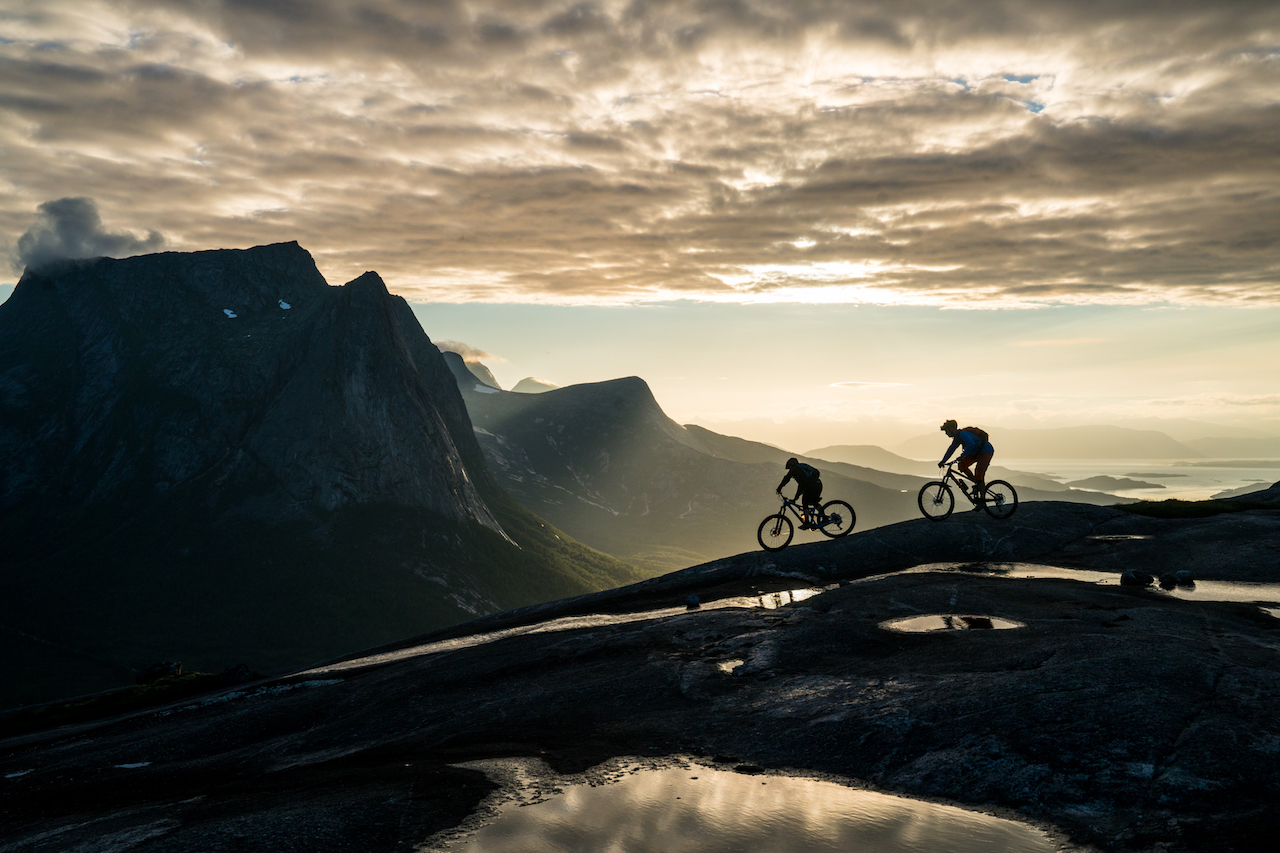
Nordland is a part of Norway that extends 300 miles northeast along the coast of the Scandinavian Peninsula. It is flanked by Sweden to the east and the Norwegian Sea to the west. Although bisected by the Arctic Circle at 65.82° N, much of the region has a unique climate, a result of the Gulf Stream and its extensions, the North Atlantic Current and the Norwegian Current. This means warm waters are funneled up from the North Atlantic Ocean into the Norwegian Sea, keeping the ice at bay and temperatures milder than other locations across the globe at similar latitudes. Known worldwide for this positive temperature anomaly, the Nordland attracts a number of tourists like myself every year, contributing over $20 billion to Norway’s economy.
Doing my part to add to the bottom line, I looked forward to exploring trails throughout the region. Since much of the time spent on the guided trip with Big Mountain Bike Adventures would focus on Lofoten, I focused my extra time on Narvik and its surroundings. Without much knowledge regarding the riding scene, I hit the ground with a few basic questions that would need to be answered quickly to get me ready for action: What was the dirt like? Where are the trails that showcase the landscape? What do the locals ride? Honestly, it was a bit of a mystery.
But mystery makes for memorable trips, especially if you travel with the right people. Fortunately for me, a good friend and accomplished athlete, Jaime Hill, would be joining me for the duration. As I’ve come to find out on previous adventures with Hill, she is always up for anything, anywhere, anytime. Like me, she was eager to travel to northern Norway. For her, the trip would be a nice respite from her nonstop racing and coaching schedule.
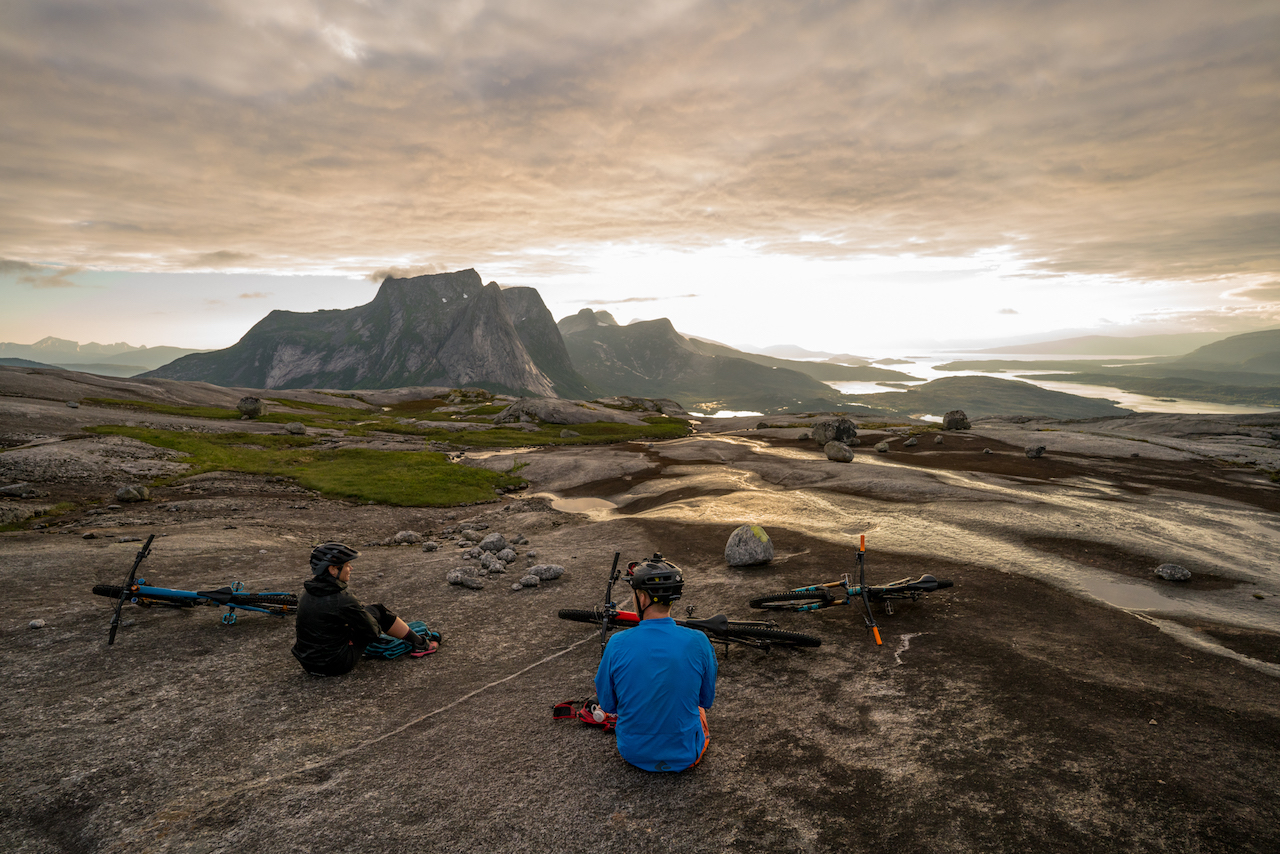
Narvik
On Day 1 we assemble our bikes and then address our plan (or lack thereof) for the next few days. We would sample the trails, rideable from town, and then try to connect with some locals. As luck would have it, Wild North Adventures had posted a flyer in the entryway of our guesthouse with two eye-catching photos. It looked great to us and we immediately sent off an email. An hour later I was making arrangements to spend the next two days riding around Narvik with local guide Daniel Larsson.
Narvik is one of the three largest towns in the Nordland, and its administrative center. Surrounded by monolithic mountains to the east and shielded by the waters of Ofotfjord on the west, Narvik, like most of the region, is strikingly beautiful. At the lower elevations, thick green and white forests of silver birch blanket the lower flanks of the steeply rising peaks. Above treeline, sheer walls of granite are capped with snow and blue-tinted glaciers. Although the main industry for the area is iron ore, Narvik is also a natural outdoor playground. Already known for its wealth of skiing and climbing, the same landscape lends itself very well to mountain biking, Hill and I discovered.
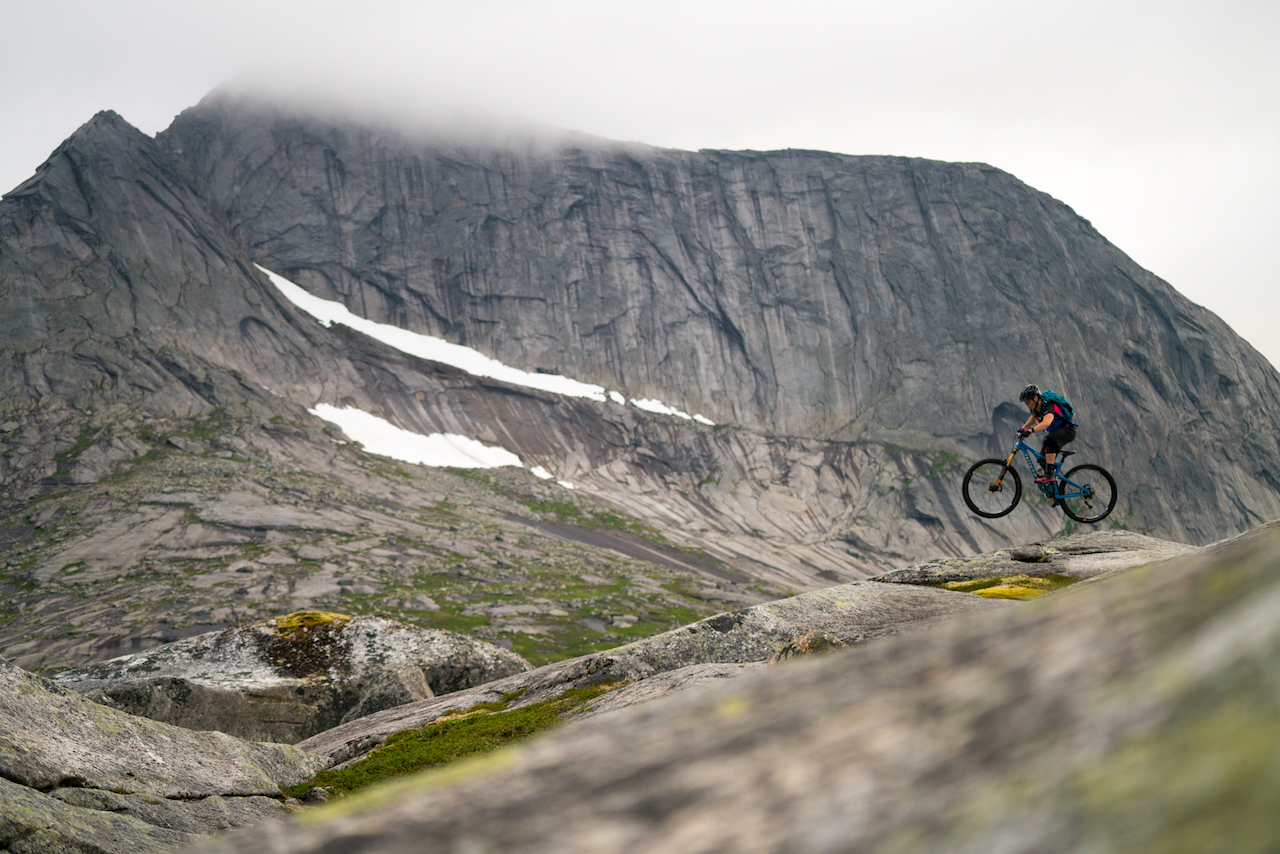
On Day 2, as planned, Larsson appears on the deck of the guesthouse with maps in hand and we get to the business of planning our time with him. Together we decide on a strategy that will allow us to experience the not-so-well-known places in the area. With a loose plan in hand, we load our bikes and gear into Larsson’s faded blue Volkswagen van and head south toward Skarbergflåget and Henriknesfjellet.
For Larsson, the Nordland is home. A native of Sweden, the natural-athlete-turned-guide moved to a small cabin at the end of a fjord about a year ago. On the drive south, we quickly observe that Larsson is the strong and silent type, with a huge smile and an assortment of bicycle-themed tattoos. Despite his being a man of few words, Hill and I easily understand his passion for mountain biking.
As the first ride gets underway, we discover that Larsson isn’t an average mountain biker. Like Hill, he’s got skills beyond most people. During the second ride of the day, at the remarkably beautiful Henriknesfjellet, Larsson announces, “I’m going over there.” I’m in the process of lining up a shot of moody clouds draped over a sheer and steep wall of granite when he rides up onto a boulder and into my viewfinder. As I’m admiring the composition of the fluorescent green lichen contrasted against dark gray rocks, Larsson declares, “I’m going to do this.” Not finding the right English words for “nose wheelie,” he proceeds to maneuver up onto his front wheel and manual down the edge of the boulder with delicate precision. Not exactly ready for this particular moment, I instinctively press the shutter button, capturing a few frames of the move. I pop my head up and smile at Hill, who’s looking back at me with excited amazement.

“Can you do it again?” I ask Larsson. He nods, pedals back up and does the move with perfect form until I’m satisfied with the shot. He and Hill ride off to another area and I linger for a few seconds to soak up the moment. In a world where mountain biking, in many places, is developing with a lot of intention, it’s refreshing to find places that are natural, untainted playgrounds.
We run out of light and call it a day. Hill succumbs to jet lag and naps in the car on the drive back to Narvik as I watch the last bit of colors from the sunset spread out into a fan across the fjord waters.
The second day with Larsson is an entirely new set of adventures and we make the most of our time with him. Although it would be hard to beat descending the giant 1,150-foot continuous wall of solid granite slickrock at Henriknesfjellet, an afternoon following a 120-year-old historic railroad supply route that starts in Sweden is equally scenic and special. What’s more, is the ride ending with a RIB-boat shuttle across the upper end of Rombakfjord.
For the icing on the cake, we finish Day 3 on trails around Ankenes, an area that is being developed with more trails. The ride, a local favorite, takes us through twisted forests of birch on some fantastically loamy dirt. The views are incredible and it is a nice departure from the solid rock we have become accustomed to. The soil is just grippy enough, the right mix of fluffy dark earth and tiny grains of rock. It makes for some playful moments with sufficient drift before the tires dig in.
With some seriously great experiences in the books and most of our “What will the riding be like?” questions answered, Hill and I find ourselves extremely grateful for the extra time spent in Narvik. We rinse out the chamois and the shorts in preparation for the Lofoten segment of the trip.
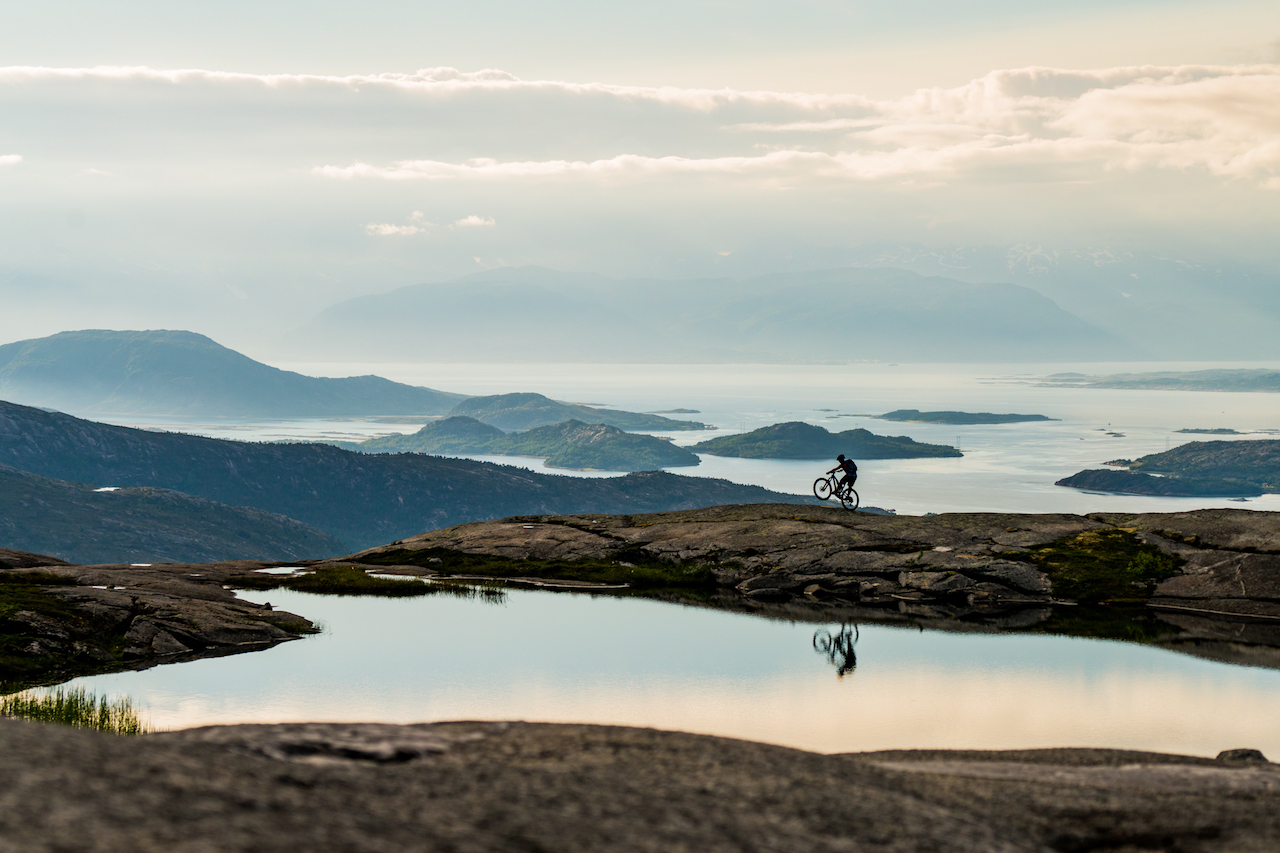
Lofoten
“It’s not smelling anymore because it’s so dry,” explains local mountain biker Sture Pettersen as the wrinkled, sunken-in head of a drying cod swings and jiggles back and forth from a string on the rearview mirror of his 1990s-era Volkswagen truck.
Pettersen, an area local and friend of our Big Mountain guide, has joined our group spontaneously for Day 8 of the trip. We’re driving west on the E10 from the town of Svolvær, toward Vestvågøy, the island that sits firmly in the heart of Lofoten.
“It’s actually a … what do you call this smelly thing, you know? To get the good smell in the cars,” he asks in English with a thick Norwegian accent.
“An air freshener?” I say.
He nods in agreement and proclaims, “This is also an air fresher. Lofoten style.”
Although the fish head is obviously part and parcel of Pettersen’s eclectic style of vehicle decoration, it’s not an uncommon thing to see in this area. Arctic cod, also known as stockfish, is very integral to life in Lofoten. Every winter from mid-February to April, millions of fish migrate from the Barents Sea to the islands to spawn. The fishery is Norway’s biggest and oldest, dating back to sometime around 1100. Although stockfish is no longer the country’s biggest export, it once supported an industry of 30,000 fishermen and became a key link between Norway and the rest of the world. It still provides a strong economic base in the region and is a key attraction for tourists. Our previous night’s stay in Svolvær was arranged in a traditional fishing hut called a rorbuer. These simple red-and-white cottages, situated over the water and supported by stilts, were once inhabited by fishermen during the stockfish season. Now the authentic buildings make a perfect base for our mountain bike adventures.
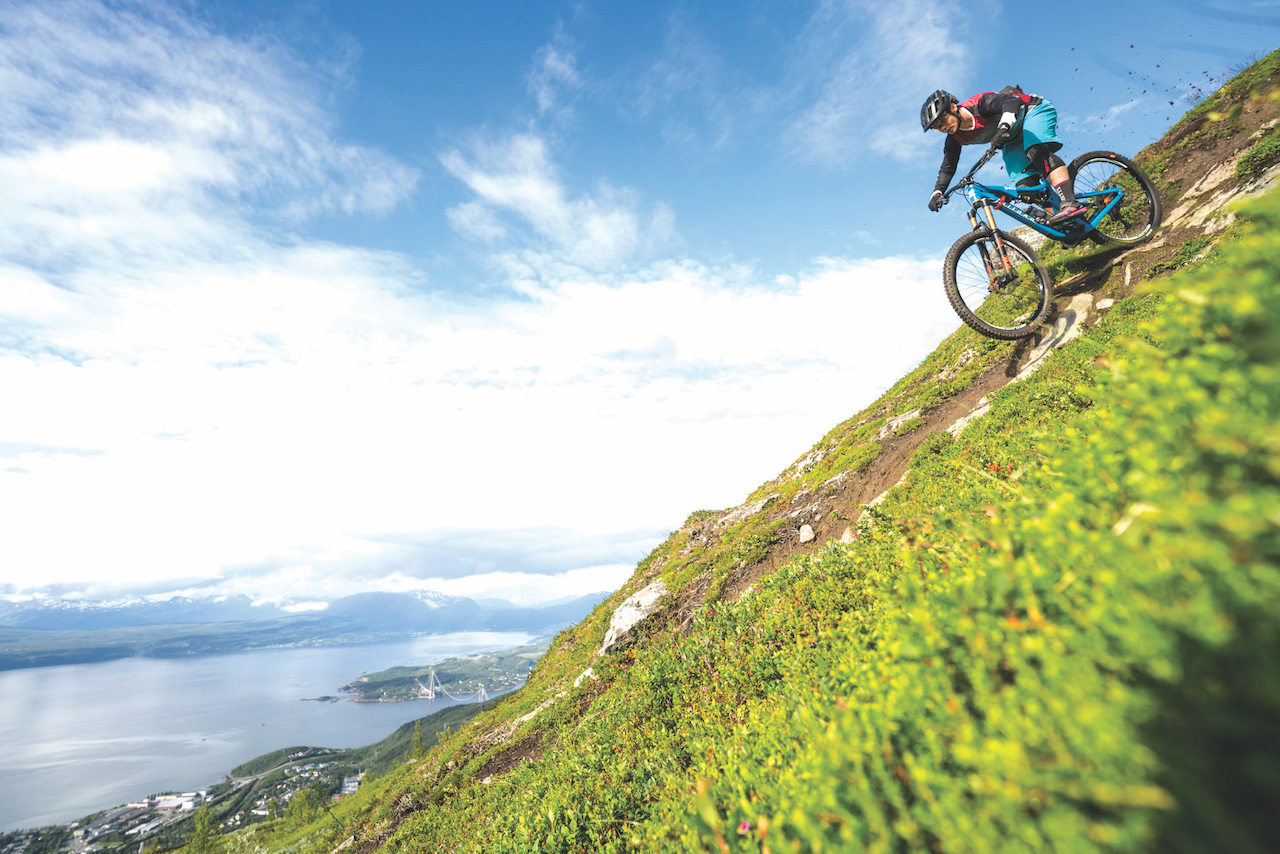
Hill and I have been riding with the Big Mountain group for a few days. After pulling an all-nighter on Reinesfjellet, we have been progressively working our way across Lofoten. The riding is similar to Narvik, with a mix of forest trails and slickrock fun. However, landscape and scenery have changed quite dramatically and we start to realize why so many travelers make a beeline for the area.
Although we’re visiting in between seasons, signs of stockfish are everywhere. Near the clusters of rorbuer lay what looks to be extensive scaffolding, built from thick, round timbers. In actuality, these are drying racks for fish. While some racks are only 6 feet off the ground, others are constructed in a pyramid, rising upward of 30 feet. During the season, these racks are key to preserving the fish. The process has been in place for nearly a thousand years and does not require salting or smoking. The unique climate in Lofoten is the key ingredient in this scenario. Since winter temperatures rarely dip much below freezing, the fish simply dry in the wind and sun without rotting or breaking into pieces. While the main body of the fish is packaged and transported to fine restaurants in other countries, such as Italy, the heads, like the one hanging inside Pettersen’s truck, are exported to various countries on the African continent to be ground into powder and used as a protein source in soups.
Pettersen proves to possess a wealth of knowledge about both the history of the cod industry and the best places to ride a mountain bike. He’s also a link between Narvik and Lofoten. After living in Narvik for 20 years, he’s recently returned to his birthplace of Svolvær, a major hub in Lofoten. At age 55, with a tall and wiry frame, Pettersen would give you the impression that he’s been riding for much of his life. Surprisingly, he’s been at it for only a decade. Somehow in those 10 years, he’s racked up enough rides to be one of the most knowledgeable people in the area. As we talk, there’s no doubt that his experience is directly linked to his passion for riding.
“It’s very difficult for people who don’t mountain bike, to explain to them how fun it is to go riding,” shares Pettersen. “If I can’t go riding for some days, I get crazy; I have to go ride. It’s so much fun. It doesn’t have to be technical or anything like that. It’s just fun to go biking.”

When Pettersen lived in Narvik, he took a year and a half off from his job as a graphic designer to ride every day. He documented his favorite experiences and created a website called singletracknarvik.com. I discovered his site while researching the trip — one of the few resources for mountain biking routes in this part of Norway. The website definitely gave me a sense of the rugged topography found throughout the Nordland.
“Lofoten is very special,” shares Pettersen. “I lived in Narvik for 20 years; it’s situated on a very long and beautiful fjord. But Lofoten … it’s such a big difference with the mountains that go straight up from the ocean. It’s more open and you have the sea.”
Lofoten is an archipelago that stretches 70 miles from east to west into the Norwegian Sea. The area has a dramatic landscape of steep mountains — some of the oldest granite in the world — surrounded by the shimmering turquoise waters of deep fjords and sheltered bays with miles of shoreline, some of which have remained untouched. Our Big Mountain guide, Andreas Tonelli, who has been guiding in Lofoten for seven years, describes the area as “paradise.”
Pettersen flicks his turn signal and we bank left into the Lofoten tourist center. Here, the rest of the group is gearing up for the longest ride of the tour, a route with two summits. It turns out to be one of my favorite rides of the trip. The experience is very much how Pettersen and Tonelli have described Lofoten, with steep topography in a wild setting. They’ve even, perhaps, understated the remarkable beauty.

Distracted by the scenery, I almost run into Pettersen about halfway up our first hike-a-bike of the day. I see that he is stopping abruptly to squat down to pick blueberries on the steep hillside. With one hand holding the bike, the other hand is rummaging through the green thicket, picking berries and shoving them in his mouth as fast possible.
Pettersen, who is not shy about using expletives, exclaims, “F–k. Can you believe how big these blueberries are?!” as he closes his eyes and pops another handful in his mouth.
As I wait for Pettersen to get back on his bike, I cannot stop looking at the ocean and mountains in the distance. A few minutes later, we are riding again, crossing the top of a long, flat ridge with views that go on forever. It is so cliché, but words are hard to find to describe the scene. Tonelli’s’ distinction of “paradise” seems to be the most fitting. Shangri-la might work too. Whatever way you describe Lofoten, it is undeniably unique.
After finishing what Hill and I refer to as the “two summits” ride, we cherish the fact that we still have more trail ahead of us. Although the routes seem to be quite steep and rugged, we agree that they offer an experience that’s not easily replicable. Our point is proven the following day while hiking the bikes up to the summit of Justadtinden, at 2,421 feet. At the top, we find ourselves in yet another 360-degree view and swear we can see all the way east, back to the area where we had our first ride with Larsson. He had pointed out the mountains of Lofoten to us that day, explaining how big and sharp the peaks would be.
On Day 10, Hill and I, along with the rest of the group, thoroughly enjoy the last few hours of riding, at Smørdalskammen. It’s more of the same: narrow and natural singletrack through the jaw-dropping scenery. We certainly don’t take it for granted, since we happen to finish just before a deluge of rain hits Lofoten. As we drive back to the small village in Nusfjord to pack and spend our last night in the traditional rorbuer, I reflect on another trip to a far-flung region of the world.
I’m always recharged by trips such as this one, having the opportunity to visit places that are raw, natural and beautifully unrefined. And I’m glad I didn’t know what I was getting into. It made the experience all the better.